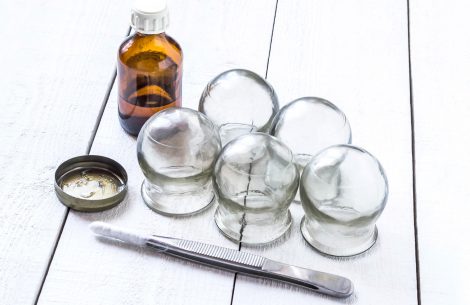If you are experiencing unresolved pain in your back and traditional treatments haven’t helped, you may want to check out cupping.
Cupping is a Chinese Traditional Medicine (TCM) technique that involves the placement of specially designed cups on strategic places of the body to relieve pain and help with other health issues. It has been shown to help with back pain.
Cupping has been used in China for over 3,000 years. Often, it’s incorporated with other healing techniques such as acupuncture, massage, or aromatherapy. Many celebrities and athletes embrace the practice. You may remember seeing photos of celebrities or athletes with round marks on their skin like Jennifer Aniston at the Academy Awards in 2013.
At the 2016 Olympics, members of the swim and track and field teams used cupping therapy. Ralph Reiff, a sports performance expert who worked with more than 100 members on the 2016 U.S. Olympic team, said that cupping was a common practice among athletes he advised. The Olympic team used it to increase motion and remove subtle tissue lesions, according to Reiff.
Theory Behind Cupping
Based on the meridian principle of TCM, the body consists of energy channels that can become blocked and lead to illness. Cupping unblocks the energy in the targeted areas.
As the cup creates suction, a vacuum happens. This vacuum allows the soft tissue and the capillaries to expand.
Enlarged capillaries cause an increase in blood flow to the area. The enlarged capillaries also allow fluids to enter and leave the tissue. Nutrients and oxygen get to the targeted regions more effectively, which helps with healing and encourages relaxation. Basically, cupping enhances circulation, which can reduce pain and remove toxins from the body by clearing blocked tissue.
How Is Cupping Done?
There are two main styles of cupping: dry and wet. Dry cupping is more common than wet cupping. The cups used can be silicone, rubber, bamboo, or glass. In traditional treatments, the cupping practitioner heats the inside of a cup then places it on the patient. The cooling of the air inside creates suction and a vacuum.
Modern techniques use glass cups & a vacuum pump to create the suction. In both techniques, the cups remain in place for a few minutes or up to twenty minutes. Marks left on the skin are a result of blood vessel and tissue expansion.
Cupping is similar to acupuncture in principle: Both are based on the TCM principle of qi (one’s energy life force). Both open up treated areas for better blood flow, which improves qi. They expel stagnation in the body. In TCM, stagnation is a cause of disease and illness. However, cupping differs from acupuncture in that no needles are used. Acupuncturists may use cupping in addition to using needles, known as needle cupping.
While relatively safe, this procedure needs to be done by someone trained in cupping. Many acupuncturists are trained in cupping. In China, the art of cupping is handed down from family to family. Other cultures also have a history of cupping as a medical therapy. Ebers Papyrus, an ancient Egyptian medical text from around 1,550 B.C.E mentions cupping. Cupping is also used in Middle Eastern cultures.
Benefits of Cupping
These are some of the purported benefits of cupping:
- Reduces pain
- Encourages relaxation and reduces stress
- Improves sports performance
- Eases stiffness
- Releases deep tightened tissue similar to deep tissue massage
- Engages parasympathetic nervous system that reduces anxiety
- Reduces cellulite
- Treats acne
- Breaks up scar tissue
- Enhances immune function
- Helps heal respiratory illnesses, such as the common cold
- Aids digestion
- Drains lymphatic system
- Removes toxins
Cupping is another tool in the toolbox of natural and holistic remedies that are available as a complementary, integrative, or as an alternative healing therapy. When conventional medicine doesn’t work or isn’t effective, it’s good to have other known and researched options. Anyone considering checking out cupping should obtain the advice of their healthcare practitioner, especially if they are under medical treatment or are taking medications.
This information is for educational purposes only. It is not intended to diagnose, treat, or promote any medical remedy.
References:
- Axe, Dr. Cupping Therapy: Alternative Medicine for Pain, Immunity, & Digestion. Retrieved from https://draxe.com/cupping-therapy/.
- Cupping Therapy. Retrieved from https://www.webmd.com/balance/guide/cupping-therapy#1.
- Peter, Josh. How cupping works and why Olympic athletes use it (August 8, 2016). Retrieved from https://www.usatoday.com/story/sports/olympics/rio-2016/2016/08/08/how-cupping-works-and-why-olympic-athletes-use/88410804/.

